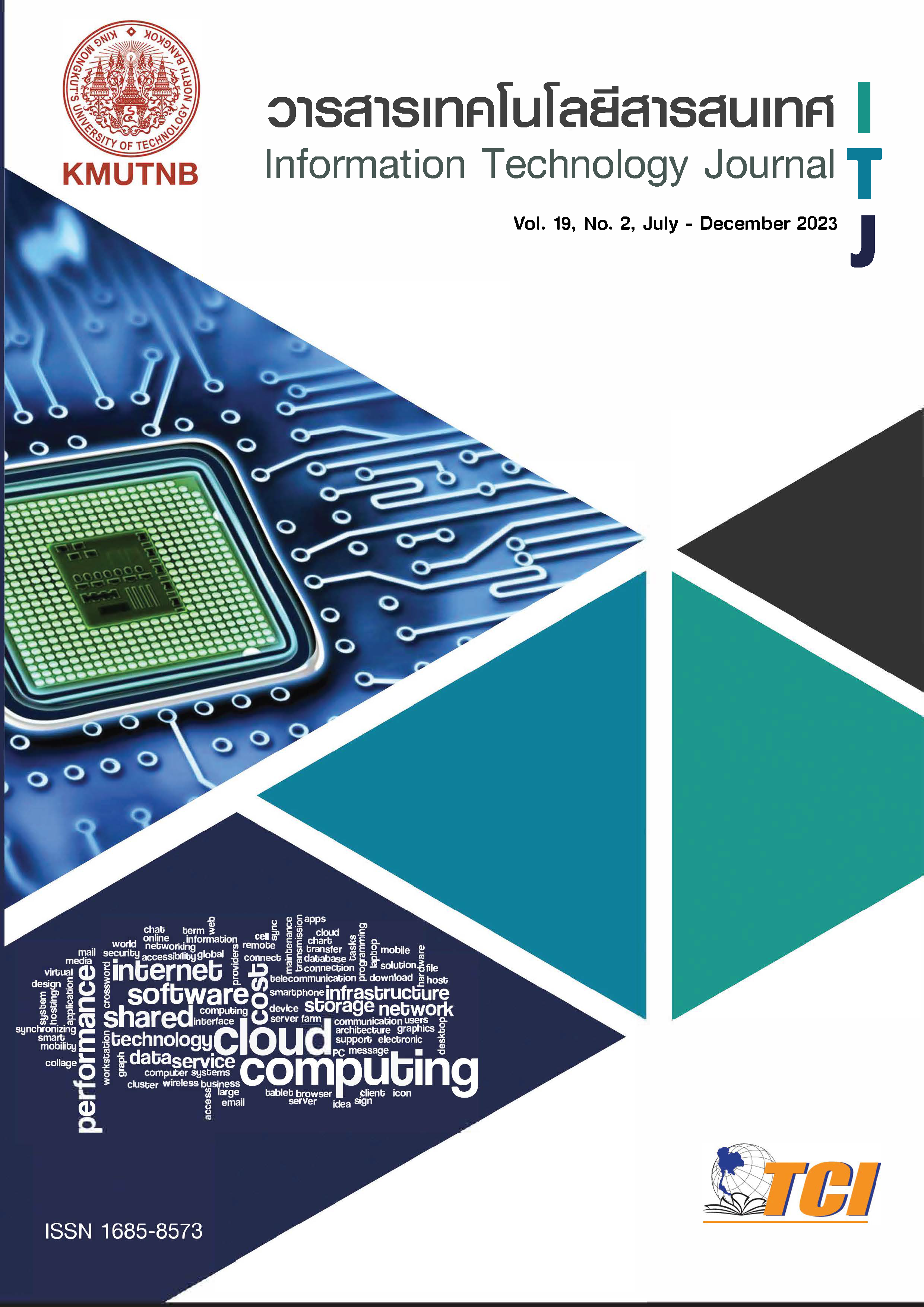Building ESexpert: The Machine Learning System for Voice Interactive Interview Score Assessment for Student Loan Funds
Main Article Content
Abstract
Scholarship applicants' interviews generally last from an hour to an entire day. Several critical situations of each student caused the interviewer's feelings, such as stress, sadness, and anxiety. Listening to and discussing negative points can cause mental health problems. In order to decrease the duration of interviewing, This research paper discusses the development of a machine learning model for evaluating Student Loan Fund interview scores and an automated voice-based interactive machine learning interview scoring system. The process consists of building a machine-learning model using the Random Forest Algorithm with an accuracy of 99.54% and the SMOTE method to adjust the data asymmetry. The software was developed as a web application based on the SDLC for a second process, running Cloud Speech-to-Text of Google Speech API. Experts in all five areas evaluated the software, and the evaluation score was high. The research also looks at the Software Development Life Cycle (SDLC) models and the use of cross-validation and bootstrapping for accuracy estimation and model selection.
Article Details
References
S. Thomas, et al. “Promoting mental health and preventing mental illness in general practice.” London Journal of Primary Care, Vol. 8, No. 1, pp. 3-9, February, 2016.
M. Chen, K. Shen, R. Wang, Y. Miao, Y. Jiang, K. Hwang, Y. Hao, G. Tao, L. Hu, and Z. Liu. “ Negative information measurement at ai edge: A new perspective for mental health monitoring.” ACM Transactions on Internet Technology, Vol. 22, No. 3, pp. 1-16, January, 2022.
E. E. Lee, et al. “Artificial intelligence for mental health care: clinical applications, barriers, facilitators, and artificial wisdom.” Biological Psychiatry: Cognitive Neuroscience and Neuroimaging, Vol. 6, No. 9, pp. 856-864, September, 2021.
P. H. Winston. Artificial intelligence. 2nd ed., Boston, United States: Addison-Wesley Longman Publishing Co., Inc., 1994.
N. J. Nilsson. The quest for artificial intelligence. United States of America: Cambridge University Press, 2010.
G. Rong, A. Mendez, E.B. Assi, B. Zhao, and M. Sawan. “Artificial intelligence in healthcare: review and prediction case studies.” Engineering Journal, Vol. 6, No. 3, pp. 291-301, March, 2020.
T. M. Mitchell. “Does Machine learning Really Work?.” AI Magazine, Vol. 18, No. 3, pp. 11-20, September, 1997.
M. I. Jordan and T. M. Mitchell. “ Machine learning: Trends, perspectives, and prospects.” Science Journal, Vol. 349, No. 6245, pp. 255-260, July, 2015.
N. Horning. “Random Forests: An algorithm for image classification and generation of continuous fields data sets.” In Proceedings of the International Conference on Geoinformatics for Spatial Infrastructure Development in Earth and Allied Sciences, Osaka, Japan, Vol. 911, pp. 1-6, 2010.
J. Dou, A. P. Yunus, D. T. Bui, A. Merghadi, M. Sahana, Z. Zhu, and B. T. Pham. “Assessment of advanced random forest and decision tree algorithms for modeling rainfall-induced landslide susceptibility in the Izu-Oshima Volcanic Island, Japan.” Science of the total environment Journal, Vol. 662, pp. 332-346, April, 2019.
E.S. Gokten and C. Uyulan. “Prediction of the development of depression and post-traumatic stress disorder in sexually abused children using a random forest classifier.” Journal of Affective Disorders, Vol. 279, pp. 256-265, January, 2021.
P. Nguyen, D. Tran, X. Huang, and D. Sharma. “Automatic classification of speaker characteristics.” In International Conference on Communications and Electronics 2010, pp. 147-152, 2010.
H. H. Wang. “Speech Recorder and Translator using Google Cloud Speech-to-Text and Translation.” Journal of Information Technology in Asia, Vol. 9, No. 1, pp. 11-28, November, 2021.
N.V. Chawia. K.W. Bowyer, L.O. Hall, and W.P. Kegelmeyer. “SMOTE: synthetic minority over-sampling technique.” Journal of Artificial Intelligence Research, Vol. 16, pp. 321-357, June, 2002.
R.C. Bhagat and S. S. Patil. “Enhanced SMOTE algorithm for classification of imbalanced big-data using Random Forest.” IEEE International Advance Computing Conference (IACC). IEEE, pp. 403-408, June, 2015.
S. Maldonado, C. Vairetti, A. Fernandez, and F. Herrera. “FW-SMOTE: A feature-weighted oversampling approach for imbalanced classification.” Journal Pattern Recognition, Vol. 124, pp. 108511, April, 2022.
G.D. Everatt and R. J. McLeod. “Chapter 2: The Software Development Life Cycle.” Software Testing: Testing Across the Entire Software Development Life Cycle. John Wiley and Sons. pp. 29–58, 2007.
A. Alshamrani and A. Bahattab. “A comparison between three SDLC models waterfall model, spiral model, and Incremental/Iterative model.” International Journal of Computer Science Issues (IJCSI), Vol. 12, No. 1, pp.106-111, January, 2015.
R. Wirth and J. Hipp. “CRISP-DM: Towards a standard process model for data mining.” In Proceedings of the 4th international conference on the practical applications of knowledge discovery and data mining, Vol. 1, pp. 29-39, 2000.
R. Kohavi. “A study of cross-validation and bootstrap for accuracy estimation and model selection.” In Proceedings of the Fourteenth International Joint Conference on Artificial Intelligence, Vol. 14, No. 12, pp. 1137-1143, 1995.
A. B. Shaik and S. Srinivasan. “A brief survey on random forest ensembles in classification model.” In International Conference on Innovative Computing and Communications: Proceedings of ICICC 2018, pp. 253-260, 2018.
Z. Masetic and A. Subasi. “Congestive heart failure detection using random forest classifier.” Journal Computer methods and programs in biomedicine, Vol. 130, pp. 54-64, March, 2016.
J. Thongkam, G. Xu, Y. Zhang, and F. Huang. “Toward breast cancer survivability prediction models through improving training space.” Journal Expert Systems with Applications, Vol. 36, No. 10, pp. 12200-12209, December, 2009.
S.V. Stehman. “Selecting and interpreting measures of thematic classification accuracy.” Journal Remote Sensing of Environment, Vol. 62, No. 1, pp. 77-89, 1997.
S. Balaji and M.S. Murugaiyan. “ Waterfall vs. V-Model vs. Agile: A comparative study on SDLC.” International Journal of Information Technology and Business Management, Vol. 2, No. 1, pp. 26-30, June, 2012.


